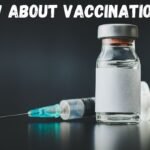Introduction
Your genetic makeup, age, and certain medical problems can all raise your risk of hypertension. One type of treatment that is possible is medication.
The amount of blood flowing through your blood vessels and the resistance the blood encounters when the heart pumps determine your blood pressure.
When the force of blood pushing through your vessels is constantly too great, it results in high blood pressure, also known as hypertension. In this article, we will cover the fundamentals of hypertension, including its signs and symptoms, causes, and treatments.

High blood pressure: what is it?
- Vascular blood vessels, also known as arteries, provide greater blood flow resistance. Consequently, the more resistant and narrower your arteries are, the higher your blood pressure will be. Over time, this high pressure could lead to several health issues, including heart disease.
- It is common to have hypertension. In fact, over half of adult Americans may now have this condition, according to 2017 criteria modifications.
- The development of hypertension typically takes several years. Most of the time, none are present at all. Even if you don’t have any symptoms, high blood pressure can still damage your blood vessels and organs, including the kidneys, heart, brain, and eyes.
- It’s critical to spot problems early. Regular blood pressure checks can assist both you and your physician in identifying any changes. If your blood pressure is higher than usual, your doctor may want you to keep an eye on it for a few weeks to see if it drops or stays higher.
- Prescription medicine and healthy lifestyle modifications are both part of the treatment for hypertension. Furthermore, heart attacks and strokes are just two of the health issues that can arise from untreated illnesses.

How to interpret increased blood pressure measurements
A reading of blood pressure is made up of two numbers. The top number, or systolic pressure, represents the pressure within your arteries during a heartbeat and blood pumping. The measurement of the pressure in your arteries in between heartbeats is called diastolic pressure (bottom number).

Adult blood pressure readings fall into five categories:
- Well, a normal measurement for blood pressure is less than 120/80 mm Hg (millimeters of mercury).
- Elevated: The diastolic value is less than 80 mm Hg, while the systolic value is between 120 and 129 mm Hg. Medication is rarely used by doctors to treat high blood pressure. To help lower your levels, your doctor might instead advise making lifestyle adjustments.
- In the first stage of hypertension, the diastolic or systolic blood pressure reading falls between 80 and 89 mm Hg.
- Hypertension in Stage 2: 90 mm Hg or more is the diastolic number, while 140 mm Hg or more is the systolic number.
- When a person has a hypertensive crisis, their diastolic or systolic blood pressure is greater than 120 mm Hg. When blood pressure is in this range, immediate medical intervention is needed. An emergency hospital visit is required if any symptoms, such as headache, shortness of breath, chest pain, or vision abnormalities, appear when blood pressure is this high.
- A pressure cuff is used to take a blood pressure reading. It’s critical that your cuff fit in order to get an accurate reading. A cuff that fits poorly could give false readings.
- Children and teenagers have varying blood pressure readings. If you are urged to keep an eye on your child’s blood pressure, ask the doctor what the healthy levels are for them.
What signs of high blood pressure are present?
In most cases, hypertension is a quiet illness. Many won’t even exhibit any symptoms. It could take years or even decades for the sickness to worsen to the point where symptoms start to show. Nevertheless, comparable symptoms may be the result of different issues.
Signs and symptoms Among the hypertension
- bleeding areas in the eyes that are flushed (subconjunctival haemorrhage)
- lightheadedness
- The American Heart Association Trusted Source states that, contrary to popular opinion, nosebleeds and headaches are not typically connected to severe hypertension unless a person is going through a hypertensive crisis.
- Taking your blood pressure regularly is the most effective way to determine whether you have hypertension.
- At every appointment, the majority of doctor’s offices take a blood pressure reading.
- If you only have annual physicals, talk to your doctor about your risk for hypertension and any additional measurements you might need to help control your blood pressure.
- For instance, your doctor might recommend getting your blood pressure checked twice a year if you have additional heart disease risk factors, such as a family history of the illness. This practice alerts you and your doctor to any potential issues before they escalate.
- If you only have annual physicals, talk to your doctor about your risk for hypertension and any additional measurements you might need to help control your blood pressure.
- In the event that you possess additional heart disease risk factors, such as a family history of the ailment, your physician might advise getting your blood pressure examined twice a year. This alerts you and your doctor to any possible issues before they get out of hand.
- If you only have annual physicals, talk to your doctor about your risk for hypertension and any additional measurements you might need to help control your blood pressure.
A dietary predisposition to hypertension exists in certain individuals. Gene mutations or genetic anomalies acquired from your parents could be the cause of this.
Age: The risk of hypertension is increased in those over 65.
Race: non-Hispanic black people are more likely to develop hypertension.
Living with obesity: Being obese can cause hypertension and other heart-related problems.
High alcohol consumption: Men and women who regularly consume more than two drinks a day and more than one drink a day, respectively, may be more susceptible to hypertension.
living a very sedentary lifestyle: lower levels of fitness and hypertension are related.
Living with diabetes and/or metabolic syndrome: People who have been diagnosed with metabolic syndrome or diabetes are more likely to develop hypertension.
High sodium consumption: There is a tenuous link between hypertension and a daily high sodium intake of more than 1.5 grams.
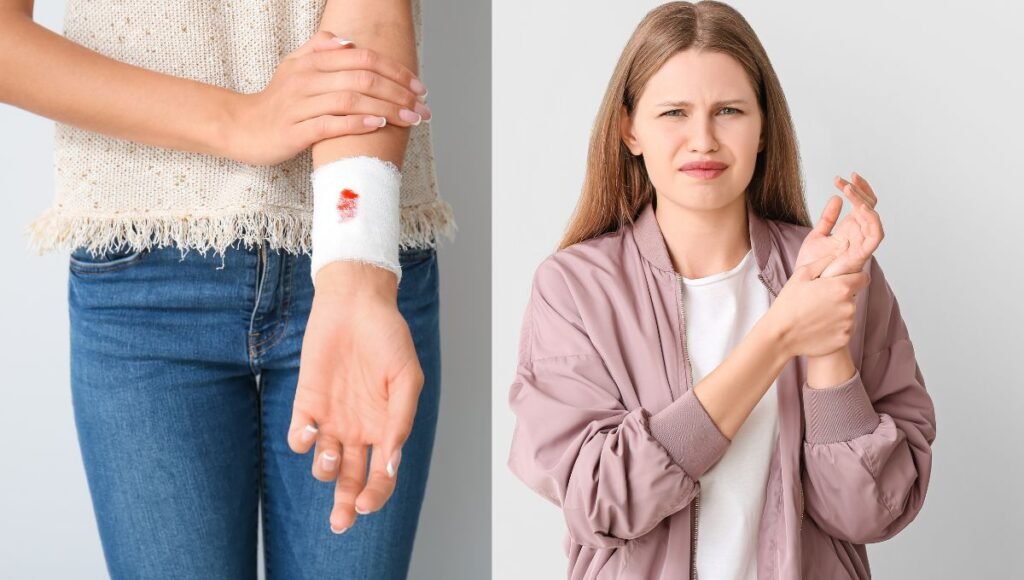
Why does hypertension occur?
Two varieties of hypertension exist. Every kind has a distinct origin.
Important hypertension (primary)
Primary hypertension is another term for essential hypertension. It takes time for this type of hypertension to manifest. The majority of people have this type of hypertension. Essential hypertension is typically caused by a combination of the following factors:
Adjacent hypertension
Secondary hypertension usually appears quickly and has the potential to deteriorate more than primary hypertension. Secondary hypertension can result from a number of conditions, which can include:
- renal illness, obstructive sleep apnea symptoms
- birth malformations of the heart
- issues with your thyroid medication adverse effects
- use of illicit substances
- chronic alcoholism issues with the adrenal glands
- certain endocrine cancers
Making the diagnosis of hypertension
A blood pressure reading is sufficient to diagnose hypertension. Most medical offices take a patient’s blood pressure as part of routine office visits. Make a request for a blood pressure check if you don’t get one at your next appointment. If your blood pressure is very high, your doctor may want to take further readings over a period of a few days or weeks. Rarely is a single reading used to diagnose hypertension. Your physician needs proof of a persistent issue. This is due to the fact that certain environmental factors, such as the tension you could experience in the doctor’s office, can raise blood pressure. Furthermore, blood pressure changes during the day. If your blood pressure doesn’t go down, your doctor will probably request more tests to rule out any underlying problems.
These tests could include the following:
- screening for cholesterol and other blood tests
- using an electrocardiogram to measure the electrical activity of your heart (ECG, sometimes termed an EKG).
- Use a home blood pressure monitor to track your blood pressure over the course of a 24-hour period, or get an ultrasound of your heart or kidneys.
- These tests can be used by your doctor to determine whether your high blood pressure is being caused by any other issues.
- Additionally, they can look at the possible effects of high blood pressure on your organs.
- Your doctor might start treating your hypertension during this period. Receiving therapy early can lower your chance of long-term harm.
Options for treating hypertension
Your doctor determines the optimal course of therapy for you based on a number of variables. Among these are the type of hypertension you have and its recognised causes.
principal methods of treating hypertension
If primary hypertension is the diagnosis your doctor has given you, change your lifestyle to control your high blood pressure. Your doctor may recommend medication if lifestyle modifications are insufficient on their own or if they lose their effectiveness.
Options for treating secondary hypertension
Your doctor will treat any underlying issues that are causing your hypertension. Consequently, if the new medication you’re taking is causing your blood pressure to rise, your doctor may try different medications that don’t have this side effect. Hypertension may sometimes persist despite treatment for its underlying cause. Therefore, your doctor might recommend medication and collaborate with you to modify your lifestyle to lower your blood pressure. Treatment plans for hypertension often evolve; strategies that initially succeed may become ineffective over time. Therefore, you and your doctor will continue working together to improve your treatment plan.
Natural treatments for hypertension
By changing your lifestyle to a healthier one, you can control the factors that cause hypertension. These are but a handful of the most popular ones.
- creating a diet that is heart-healthy
- A heart-healthy diet is required to lower high blood pressure. It’s also essential for managing hypertension and reducing the likelihood of issues. Heart disease, strokes, and heart attacks are some of these problems.
- An emphasis on a heart-healthy diet is:
- fruits, veggies, whole grains, fish, or other lean proteins
- Increasing exercise
- If prescribed by a doctor, exercise can help you naturally lower your blood pressure, strengthen your heart, and lose weight.
- Aim for 150 minutes per week of moderate activity (reliable source). That is the same as thirty minutes, five times a week.
- Getting to a healthy weight
- Maintaining a modest weight, eating a heart-healthy diet, and increasing your physical activity can all help decrease blood pressure in obese people.
During pregnancy, elevated blood pressure
Despite having the illness, people with hypertension can give birth to healthy children. However, if the condition is not well controlled and continuously monitored during pregnancy, it can pose hazards to both the expecting mother and the unborn child. Therefore, it is crucial for healthcare providers to closely monitor and manage hypertension in pregnant women.
The risk of problems during pregnancy is increased by high blood pressure. Trusted Source. For instance, reduced kidney function may occur in pregnant women with hypertension. Additionally Premature birth or low birth weight are possible outcomes for children whose parents have high blood pressure.
Pregnancy can cause hypertension in certain people. There are various kinds of high-blood pressure issues that might arise. After the baby is born, the condition frequently goes back to normal. Pregnancy-related hypertension may raise your chance of having hypertension in the future.
Pre-eclampsia
Preeclampsia can occasionally develop in pregnant individuals with hypertension. Renal and other organ issues may result from this elevated blood pressure disease. This may lead to elevated levels of protein in the urine, issues with the liver, fluid accumulation in the lungs, or vision impairments.
The hazards to both the mother and the unborn child rise as this illness gets worse. Seizures can result from eclampsia, which is preceded by preeclampsia. In the US, high blood pressure issues during pregnancy continue to be a major factor in maternal fatalities. Low birth weight, premature birth, and stillbirth are among the complications that a newborn faces.
Preeclampsia cannot be prevented; childbirth is the only known treatment for the illness. Your doctor will keep a careful eye on you in case any issues arise if this disease develops during pregnancy.
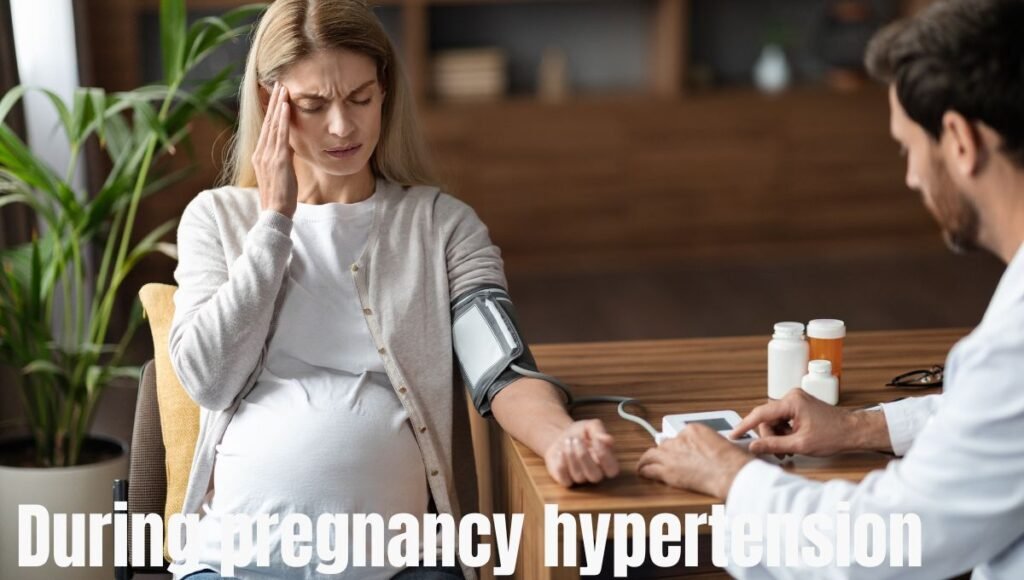
What physical impact does high blood pressure have?
Since misdiagnoses of hypertension are common, the body may be harmed years before symptoms appear. If you don’t treat your hypertension, the repercussions could be fatal.
Hypertension can result in several complications.
weakened arteries
Sturdy arteries are robust and flexible. Blood can flow freely and unhindered via healthy arteries and veins.
Arteries become less elastic, harder, and tighter due to hypertension. Dietary lipids can more easily accumulate in your arteries as a result of this damage, obstructing blood flow. Damage like this can cause blockages, elevated blood pressure, and ultimately heart attacks and strokes.
Heart damage
Too much heart effort is caused by hypertension. Your heart’s muscles must beat more quickly and forcefully than a healthy heart should because of the elevated blood vessel pressure.
Heart enlargement could result from this. Your risk of the following conditions is elevated by an enlarged heart:
Arrhythmias in the heart failure patient: abrupt cardiac death coronary heart attack
brain injury
For optimal performance, your brain needs a blood flow that is rich in oxygen. However, your brain’s blood supply may be reduced if your high blood pressure is left untreated.
Furthermore, severe blood flow obstructions result in the death of brain cells. This is known as a stroke.
Moreover, recall that speaking, thinking, remembering, and learning can all be negatively impacted by uncontrolled hypertension. Although treatment for uncontrolled hypertension often does not reverse or eradicate its symptoms, it does reduce the possibility of future problems.
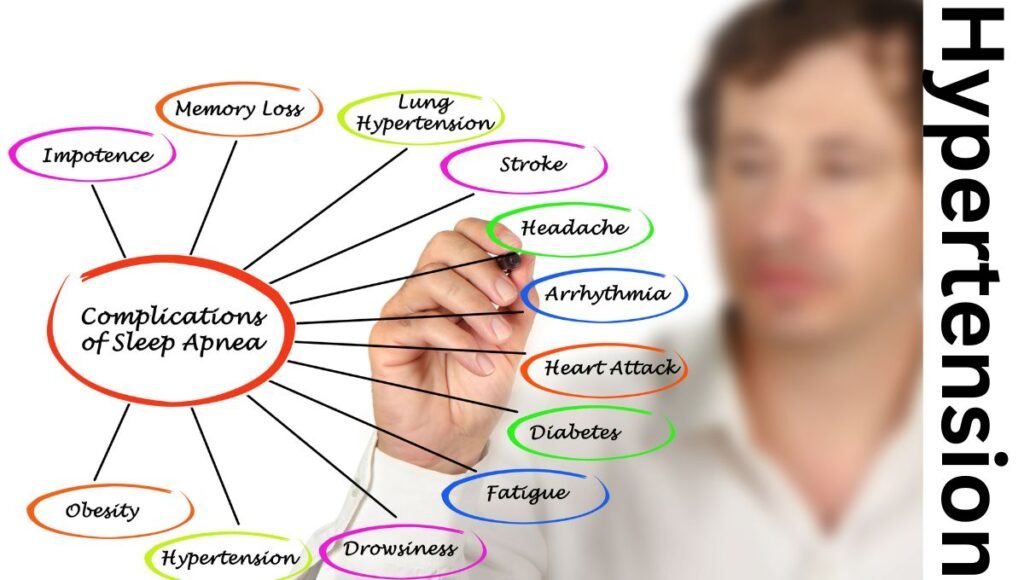
Foods That Help Lower Blood Pressure
- Vegetable greens: Potassium aids in the kidneys’ increased excretion of sodium in the urine.
- Among the leafy greens that are rich in potassium are:
- Lettuce romaine
- Arugula
- kale
- carrot greens
- greens with collards
- Beet greens with spinach
- Swiss chard
- Vegetables in cans frequently include extra salt. However, frozen vegetables are easy to store and provide an equal amount of nutrients as fresh vegetables. Blend these vegetables with bananas and almond milk to create a delightful, nutritious green juice.
Berries: Flavonoids are naturally occurring chemicals that are abundant in berries, particularly blueberries. According to one study, eating these substances may help decrease blood pressure and avoid hypertension.
It’s simple to include strawberries, raspberries, and blueberries in your diet. You can have frozen berries on hand for a simple and healthy dessert, or sprinkle some over your granola or porridge in the morning.
Beets in red colour:
Nitric oxide, which is abundant in beets, has the ability to dilate blood vessels and reduce blood pressure.
yoghurt and skim milk
Skim milk is low in fat and a great source of calcium. Both of these are crucial components of a blood pressure-lowering diet. If you’re not a fan of milk, yoghurt is another option.
As stated by the American Heart Association, According to a reliable source, ladies who consumed five or more servings of yoghurt each week saw a 20 per cent decrease in their chance of getting high blood pressure.
For added heart-healthy advantages, try adding granola, nut slivers, and fruits to your yoghurt. Make sure to look for extra sugar when purchasing yoghurt. The ideal amount of sugar per serving is less than one.
oats
A high-fibre, low-fat, and low-sodium method of lowering blood pressure is oatmeal. A healthy breakfast of oatmeal is a terrific way to start the day off strong.
Oats made the night before are a common breakfast choice. To make them, put 1/2 cup of nut milk and 1/2 cup of rolled oats in a jar to soak. Stir and add granola, cinnamon, and berries to taste in the morning.
Bananas
Consuming foods high in potassium is preferable to supplementation. To increase the potassium value of your cereal or oatmeal, slice a banana. One can also be eaten as a quick breakfast or snack with a boiled egg.
Mackerel, salmon, and omega-3-rich seafood
Lean protein can be found in abundance in fish. Omega-3 fatty acids, which are abundant in fatty fish like salmon and mackerel, can lower triglycerides, blood pressure, and inflammation. Apart from these fish sources, vitamin D is present in trout. Vitamin D, a hormone-like vitamin, rarely occurs in food but has blood pressure-lowering effects.
The simplicity of flavouring and cooking fish is one advantage of cooking it. Try it by wrapping a salmon fillet in parchment paper and seasoning it with olive oil, lemon juice, and herbs. For 12 to 15 minutes, bake the fish at 450°F in a preheated oven.
Herbs and garlic
A single evaluation, according to Trusted Source, indicates that garlic helps lower blood pressure by raising nitric oxide levels in the body. Consequently, in order to lower blood pressure, nitric oxide facilitates vasodilation, or the widening of vessels.
Additionally, by incorporating savory herbs and spices into your daily diet, you can cut back on your salt intake. For instance, you can add a variety of herbs and spices, such as rosemary, thyme, cinnamon, and basil.

Controlling tension
Exercise greatly enhances stress management.. Other pursuits may also be beneficial. Among them are:
- meditation
- deep inhalation, massage, and relaxed muscles
- Tai Chi or Yoga
-
- Giving up smoking and consuming less booze
- If you smoke and have high blood pressure, your doctor will probably advise you to quit. Compounds in tobacco smoke have the ability to damage body tissues and stiffen blood vessel walls.
- Seek assistance in reducing your alcohol use or giving it up entirely if you are an excessive drinker on a regular basis or suffer from an alcohol addiction. Blood pressure might increase with excessive alcohol use.
Tips for reducing your risk of hypertension through lifestyle
- You can take action right away to reduce your risk of hypertension and its complications if you have risk factors for the condition.
- Boost your diet with fruits and vegetables.
- Increase your intake of heart-healthy plant foods gradually. Try to acquire your recommended daily intake of fruits and vegetables, up to seven servings. After two weeks, try to increase it by one serving per day. Attempt to add one additional serving after those two weeks.
- Try consuming fewer sugar-sweetened foods on a daily basis, such as flavoured yoghurts, cereals, and sodas. Eat items packaged to avoid unnecessary added sugar; always read the labels.
Cut back on salt consumption.
-
- Eating less fast food and packaged food, which can occasionally be highly high in sodium, and cooking fresh food more frequently are the best ways to lower your salt intake.
- Establish weight-loss objectives.
- If your doctor has recommended that you lose weight, inquire about the ideal weight loss goal for you. According to the Centres for Disease Control and Prevention (CDC) Trusted Source, the recommended weekly weight loss target is one to two pounds. To achieve this, you can increase your exercise and adopt a more nutrient-dense diet.
- Using a fitness app, personal trainer, or perhaps a dietician can all assist you in learning how to make the best decisions for your body and lifestyle.
- Regularly check your blood pressure.
- The strongest defence against complications and issues is the early detection of hypertension.
- Take your blood pressure readings with you to your doctor’s appointments and keep a record of them. This can assist your physician in identifying any potential issues before the illness worsens.
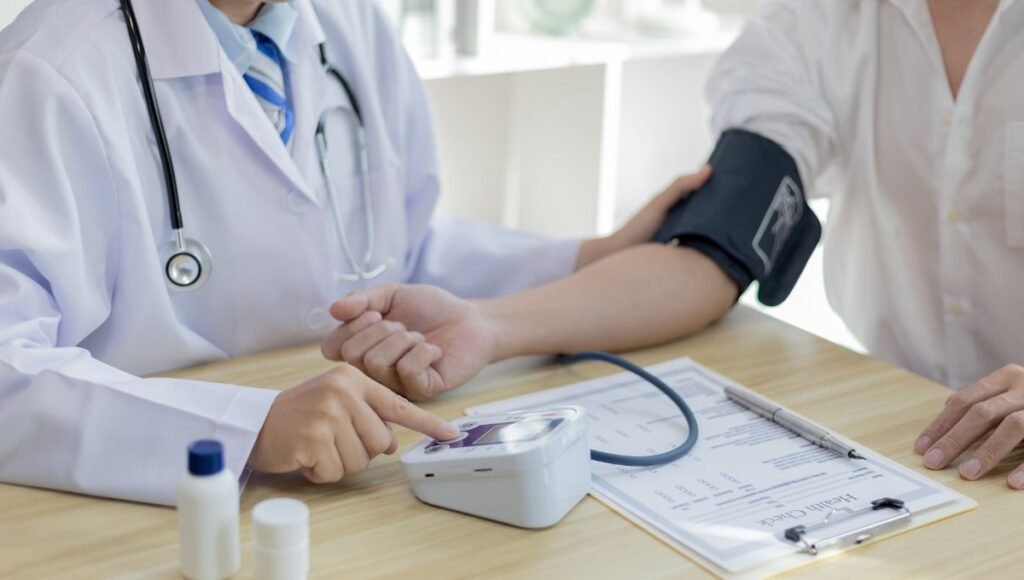
Medications
Taking blood pressure medicine often involves a period of trial and error for many people. Your doctor may need to try a number of medications before determining which one or which combination would work best for you.
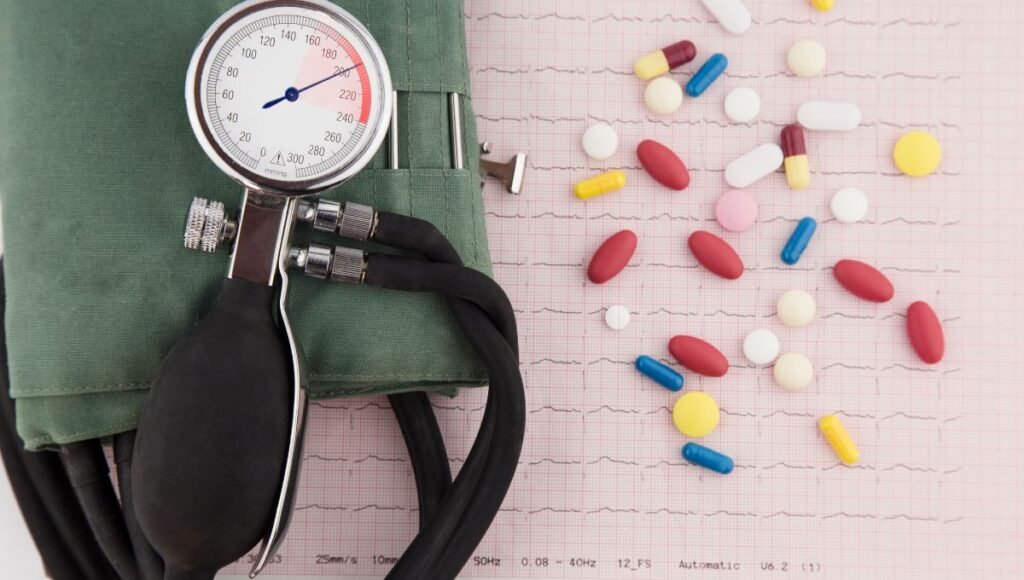
A few medications used to treat hypertension are as follows:
Beta-blockers: This drug makes your heart beat weaker and slower. Consequently, your blood pressure decreases because your arteries pump less blood with each heartbeat. Moreover, it suppresses certain hormones that raise blood pressure.
Diuretics: The body’s high salt and excess fluid content can cause blood pressure to rise. Therefore, diuretics, often known as water tablets, help your kidneys get rid of excess sodium in your body. As the sodium leaves your body, extra fluid in your bloodstream goes into your urine, resulting in a drop in blood pressure.
ACE inhibitors: Angiotensin is a chemical that causes blood vessels and artery walls to constrict and tighten. Inhibitors of the angiotensin-converting enzyme (ACE) prevent the body from producing this chemical as much. This lowers blood pressure and encourages blood vessel relaxation.
ARBs, or angiotensin II receptor blockers, ACE inhibitors prevent the synthesis of angiotensin, while ARBs prevent it from binding to receptors. The material is necessary for blood vessel constriction.
As a result, blood vessels relax and blood pressure drops.
Calcium channel blockers: These medications keep part of the calcium from getting to the cardiac muscles of your heart. This leads to gentler heartbeats and lower blood pressure. These medications also relax blood vessels, which further reduces blood pressure.
Alpha-2 agonists: These medications change the nerve signals that cause blood vessels to contract. This lowers blood pressure by assisting in the blood vessels’ relaxation.
Conclusion
High blood pressure, or hypertension, is a very common medical disease in the United States.
The good news is that changing one’s lifestyle can frequently be a successful approach to managing or even curing high blood pressure. Examples of these changes include increasing your intake of fruits and vegetables, exercising more, reducing your sodium intake, and drinking less alcohol.
Furthermore, during your annual checkup, it’s crucial to have your blood pressure checked because hypertension frequently shows no symptoms. This early detection allows for timely intervention to manage and prevent potential health complications. Early diagnosis of severe hypertension allows you to control and potentially even reverse it, thereby preventing major health problems.


